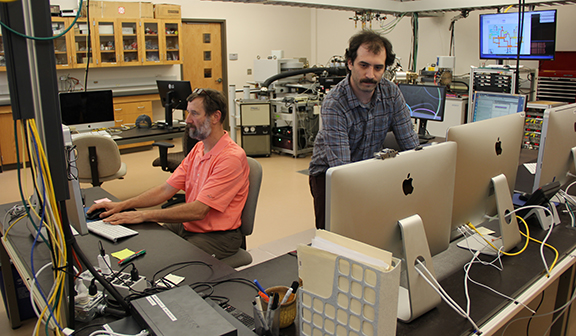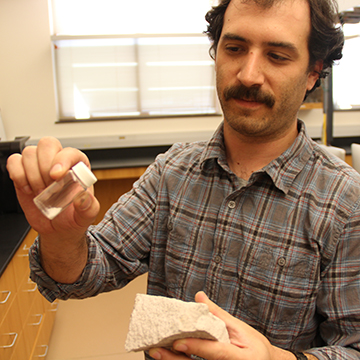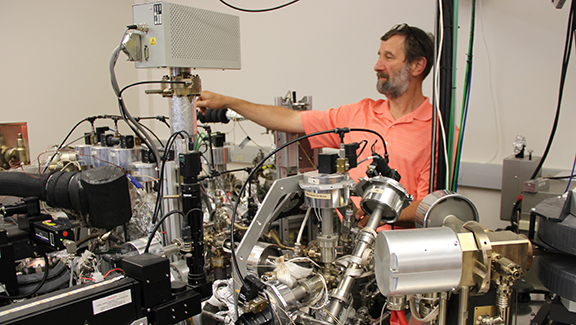NMT’s Geochronology Lab – A Pioneer In Argon Dating
Feb 20, 2018
By Thomas Guengerich/New Mexico Tech
New Mexico Tech is home to one of only a handful of Argon Geochronology Labs in the world. Scientists from all over the world send rock samples to Socorro to have Bureau of Geology experts pinpoint its age using the 40Ar/39Ar radiometric dating technique.
Most people are familiar with carbon dating, which is a tried and true method for dating organic material. However, that system of dating doesn't work with rocks – and is only appropriate for samples less than 50,000 to 80,000 years old. Argon dating is effective with samples that are thousands to billions of years old.
 Over the past 25-plus years, the New Mexico Geochronology Research Laboratory has
built a reputation for leading-edge science among scientists from a variety of disciplines.
In recent years, lab personnel have added software and hardware updates that have
allowed them to also provide extremely precise dates for sedimentary rock samples.
Over the past 25-plus years, the New Mexico Geochronology Research Laboratory has
built a reputation for leading-edge science among scientists from a variety of disciplines.
In recent years, lab personnel have added software and hardware updates that have
allowed them to also provide extremely precise dates for sedimentary rock samples.
Chuck Chapin and a group from Los Alamos National Laboratory conceived the lab in the late 1980s. Chapin, who would later become the director of the Bureau of Geology in the 1990s, cobbled together $100,000 of NM Tech funding and LANL chipped in $175,000 and some surplus equipment.
Dr. Bill McIntosh, who had been Chapin’s graduate student, secured an NSF grant in 1991 to add new equipment. Then, Dr. Matt Heizler joined the lab in 1993.
“Once we got started, we kept adding on through grants, contracts and research and we started new programs,” Heizler said. “Bill and I had different research tracks, but we clicked.”
Lisa Peters and Rich Esser joined the lab team to round out the core group.
“By 1995, all four of us were running the lab,” Heizler said. “It’s very unusual for an analytical lab to have as much staff as we did for argon geochronology. That made us capable of doing what we did. We had the personnel to date every rock on the planet.”
 Argon geochronology is a radiometric dating technique that relies on the natural decay
of Potassium-40 to Argon-40, a stable isotope. Potassium-40 has a half-life of 1.25
billion years, which means any rock sample with Potassium can be dated with some degree
of accuracy, from the volcanic eruption that destroyed Pompeii in 79 A.D to meteorites
formed at the birth of the solar system 4.5 billion years ago. A unique aspect of
40Ar/39Ar dating is the neutron irradiation of the mineral sample. The irradiation
is preformed at a research-grade nuclear reactor and is used to convert some of the
sample’s Potassium-39 to Argon-39. In the laboratory the sample is heated to release
the argon and the isotopes of Argon-39 and Argon-40 are measured using a noble gas
mass spectrometer. By measuring the ratio of Argon-39 to Argon-40, scientists can
determine the age of the sample.
Argon geochronology is a radiometric dating technique that relies on the natural decay
of Potassium-40 to Argon-40, a stable isotope. Potassium-40 has a half-life of 1.25
billion years, which means any rock sample with Potassium can be dated with some degree
of accuracy, from the volcanic eruption that destroyed Pompeii in 79 A.D to meteorites
formed at the birth of the solar system 4.5 billion years ago. A unique aspect of
40Ar/39Ar dating is the neutron irradiation of the mineral sample. The irradiation
is preformed at a research-grade nuclear reactor and is used to convert some of the
sample’s Potassium-39 to Argon-39. In the laboratory the sample is heated to release
the argon and the isotopes of Argon-39 and Argon-40 are measured using a noble gas
mass spectrometer. By measuring the ratio of Argon-39 to Argon-40, scientists can
determine the age of the sample.
At about 1 percent of the atmosphere, argon is the most abundant element in the atmosphere after nitrogen and oxygen. Therefore, every material exposed to the atmosphere will contain some quantity of argon that is considered a “contamination”. Argon geochronologists overcome this problem by preforming their experiments in Ultra-High-Vacuum chambers. These UHV chambers essentially have no atmosphere in them; the air pressure in the chamber is about 10 billionths of the air pressure at the surface of the earth or equivalent to the air pressure at in outer space.
Argon geochronology labs are rare. Less than about 25 exist worldwide. Many of them do not take outside work. New Mexico is the only state geological survey to host an Argon lab.
“People came to us for two reasons – a good product and timely results,” Heizler said. “That’s why we became so popular and still are. Bill, Lisa and I have been here for over 20 years and that’s what has made this lab what it is.”
The 2000s saw significant upgrades in technology. The lab received $1.3 million of major research instrumentation funding in 2007, which funded two ARGUS 6 mass spectrometers from Thermo Fisher Scientific. The lab staff then partnered with Thermo to develop a new generation of instruments.
“They were reluctant to sell non-standard instruments, but we wanted certain aspects,” Heizler said. “They went out on a limb and developed prototype electronics. They did the R&D and we did the beta testing and we developed unique things. That’s been our philosophy from the get-go – always pushing technology. It costs money of course, but ultimately it was the right path and kept us state-of-the-art.”
The Argon lab saw another round of upgrades in 2015 when the Bureau and then-president Dr. Daniel H. Lopez both offered seed money for new instrumentation.
“Bottom line – President Lopez was very supportive over the years,” Heizler said. “When we needed money to upgrade, he always said, ‘Yes’. … for a reason, of course. We paid it back with research grants over and over and over. So, it’s been a good synergy.”
 In addition to securing the latest-greatest spectrometers, the Argon Lab has also
made monumental leaps forward in software. Dr. Jake Ross joined the lab informally
about 10 years ago and recently became a staff scientist. Ross came to New Mexico
Tech as a master’s student from McGill University in Montreal. He earned his master’s
and Ph.D. at Tech in Earth science, followed by a post-doc at the Bureau.
In addition to securing the latest-greatest spectrometers, the Argon Lab has also
made monumental leaps forward in software. Dr. Jake Ross joined the lab informally
about 10 years ago and recently became a staff scientist. Ross came to New Mexico
Tech as a master’s student from McGill University in Montreal. He earned his master’s
and Ph.D. at Tech in Earth science, followed by a post-doc at the Bureau.
“Jake is an integral part of the state-of-the-art program development,” Heizler said. “He is really seeing opportunity and seizing it and doing something spectacular. He’s taking a whole different approach to software development and interfacing equipment. He’s providing the backbone to proceed as a community software.”
Ross has been developing a new software application that he has dubbed Pychron. Ross visited the Thermo Scientific factory in Germany where he presented his software platform six years ago. He presented his software at a global conference in Socorro in early June 2017. More than 35 scientists from around the world attended the three-day workshop on geochronology. Ross, Heizler, and McIntosh are the organizers and featured presenters. The Argon Lab team shared their breakthroughs with the global geochronology community.
“There’s been some pushback from peers who don’t have our instrumentation,” Heizler said. “When someone gets a new instrument like us, people are saying, ‘Holy cow, is that really a 5,000 year error on a 28 million year old rock?’ Yes. People say our low error doesn't factor in all the uncertainties, but we don’t think so. We’re not missing anything.”
Ross said the combination of the latest mass spectrometer technology and the new software interface allows him – and all geochronologists – to filter out trace data.
“We’re looking for a ratio of Argon-40 to Argon-39,” Ross said. “We’re only interested in the argon, but there’s other things – a lot of other stuff that we don’t want in the mass spec.”
The Pychron application provides such clear results that analysts can identify and rule out anomalous elements. That development makes the argon chronology dating technique at the Bureau 10 to 100 times more precise than previously.
“The new data is incredible. Our precision has increased by an order of magnitude,” Ross said. “We use the term ‘higher-resolving power.’ We used to see one peak [from the mass spectrometer], but now we can see that the big peak is composed of separate peaks and we can separate out other interferences. Modern electronics and modern engineering!”
Argon geochronology is more than just an esoteric pursuit. The technique has a variety of practical applications. Ross said the concept of dating starts with the motto “No Dates, No Rates.”
“In geology, we really care about the rates at which things are happening,” Ross said. “Like climate change – we can measure that climate is getting warmer, but we don’t know if it’s caused by humans. One way to get at that is how fast things changed in the past. We can assume from current measurements that climate has never changed as fast as now. So, it’s got to be humans.”
The method can be used to shed light on plate tectonics and volcanism. Also, the petroleum industry and the mining industry are also interested in dating mineral deposits.
“Geochronology has always been a part of economic geology,” Heizler said. “Hard rock mining – copper and gold are the big ones. We track industry trends at some level. When commodities are high, companies put more time and money into research and supporting our students. We’ve relied heavily on contract work to fund students, development and technicians.”
Roughly one-third of the lab’s income has come from private industry over the years. That is consistent with the lab’s research mission to divide the time into thirds – 1/3 from New Mexico, 1/3 from elsewhere in the Southwest, and 1/3 from elsewhere.
Heizler and McIntosh have each supported more than 30 graduate students over the years with argon lab funding. They’ve also employed dozens of undergraduates to run the lab. Lisa Peters has a consistent track record of finding sophomores who can work in the lab for two to three years.
“We’ve impacted a tremendous amount of undergraduates,” Heizler said. “We need them and they need us.”